Transporting pharmaceutical products can be a challenge for many shippers. Pharmaceutical logistics is a massive business around the world that generates billions of dollars each year in the U.S. alone. As a result, moving medicinal cargo is a delicate process that requires pinpoint accuracy and extreme attention to detail in order to avoid costly mistakes.
The Food and Drug Administration (FDA) and the Department of Transportation (DOT) regulate the transport of pharmaceutical products in the U.S. Temperature-controlled trucks are required to ship most pharmaceutical products. Special care and handling must be used to ensure safety and security during transportation.
Our informative guide below provides you with everything you need to know about transporting pharmaceutical products.
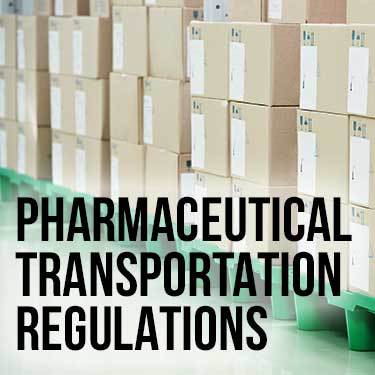
Transporting pharmaceutical products regulations are one of the biggest details you need to consider when shipping pharmaceuticals. Given the crucial nature of these goods, restrictions need to be taken seriously. The rules in place begin at the manufacturing plant and extend all the way through the supply chain and onto store shelves.
The first set of rules comes from the FDA’s Current Good Manufacturing Practices (CGMP) in regard to pharma shipping. These guidelines were first established in 1969 and set standards for the manufacturing, storage, and distribution of food and pharmaceutical products.
In 2015, these rules were updated to accommodate details included in the Food Safety Modernization Act (FSMA). Further detail provided by the FDA under the code of federal regulations (CFR) Title 21 provides greater detail on the handling and transportation of prescription drugs.
Some of the highlights of these regulations related to the shipping of pharmaceuticals include:
The above details are applicable to a pharmaceutical freight company or any carriers who transport pharmaceuticals. When looking to move freight, be sure your shipping company abides by these guidelines and is qualified and vetted. When you ship your pharmaceuticals, you should rest easy knowing that your sensitive freight will be handled and transported safely and by the law.
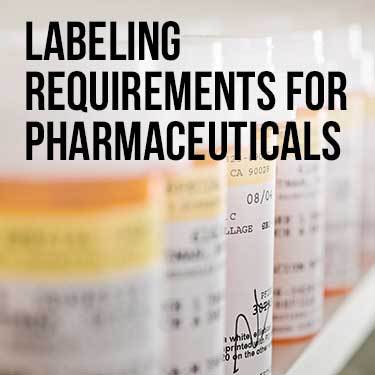
In addition to maintaining transportation requirements, the FDA is also responsible for rules governing the labeling of products. These requirements cover the information that needs to be included on each label and how these standards are enforced.
Therefore, before you even agree to ship your pharmaceuticals, you need to ensure that your products meet the proper labeling requirements. Information that needs to be included on the labels includes:
The label should be created with the following information in mind:
Curiously, the FDA does not require pharmaceutical companies to list the ingredients’ country of origin, only where the majority of the manufacturing occurredoccured. So even if 80 percent of the raw materials came from India or China, if the components were processed in the United States, then that is what is allowed to be put on the bottle.
Need help shipping other medical equipment. Check out our article and find out how we can be your trusted transporting partner for all medical and pharmaceutical goods.
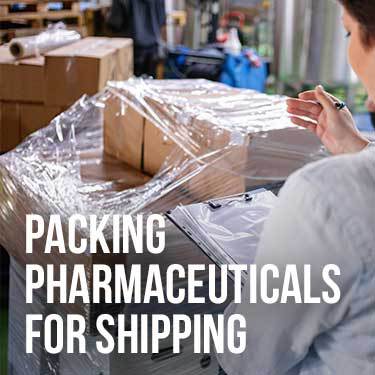
Packaging pharmaceuticals for transport requires the utmost care. Proper handling of pharmaceutical shipments can be the difference between a ruined shipment and happy customers. Climate-controlled trucks are almost always a necessity when shipping refrigerated medications. Equally important is the correct packaging and handling of the pharmaceuticals that are ready for shipping.
Insulated containers can be a big help and protect packages from heat, light, air, and moisture, as well as general potential damage during the shipping process. Roughly 70 percent of medicine needs to be climate controlled, so insulation and refrigeration are essential in most cases.
Thermal pallet covers can also be used to further protect the freight. These are custom-made covers put over the drugs while on a pallet that adds another layer of protection against temperature fluctuations. They are also puncture-proof, which means the shipper won’t have to worry about potential unnecessary damage.
Also, while it might go without saying, the boxes or containers should be packed as efficiently as possible onto pallets. The goal is to ship a large number of goods while limiting movement while in transit. Medicinal products are exceedingly fragile to transport in most cases. If the contents inside are damaged in any way, there’s a good chance the products can no longer be used or sold.
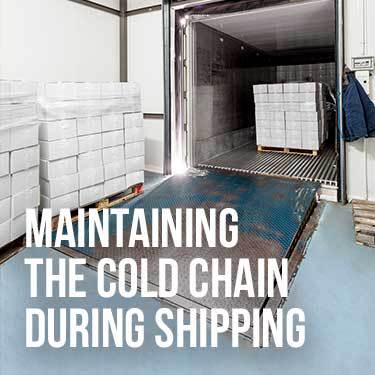
As soon as pharma products are produced, the clock starts ticking toward its expiration date. Using temperature-controlled shipping is important to ensure products don’t go bad or even just to slow down the natural deterioration of the drugs. A small shift in temperature - even just a couple of degrees too warm or cold - can spoil the shipment.
This is where cold chain logistics comes into play. Cold chain transport is the process of moving freight that requires a temperature-controlled environment through most or all of its journey. The journey begins at manufacturing and ends when the product reaches the consumer.
The cold chain is maintained at the various stages in the following ways:
Refrigerated pharmaceutical transport is important in the cold supply chain and is specially built to make sure the freight in question doesn’t run the risk of spoiling. The refrigerated trailers work separately from the trucks as they have their own power source. This allows it to run its cooling unit independently. It is set up like this so the medicine will stay cool whether it is being pulled by a truck or some other method of pharma transportation.
Ideally, the refrigeration unit inside the trailer is paired with an ample amount of insulation, which will keep the products protected from outside elements. This will also allow the cooling unit to work more efficiently and not have to overcompensate.
If you're freight shipping medical supplies along with your pharmaceutical products, we'll apply the same level of care. No matter what you ship with us, your goods will be safe, secure, and delivered quickly.
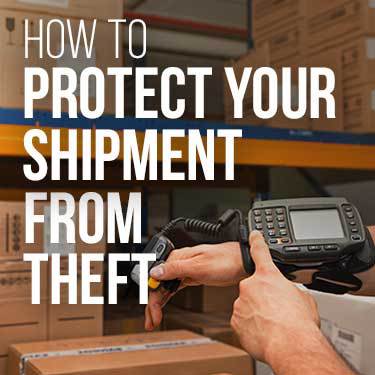
If you are transporting medications, it's an absolute necessity to have solid theft prevention protocols in place. Not only do your products likely carry a high value, but if stolen, they could end up in the wrong hands and have serious consequences.
Some of the theft prevention details relate to the shipper, while others apply to the carrier. One of the biggest precautions that shippers can take is appropriate packaging. Packaging that clearly states what is inside can be an invitation to potential theft. Nondescript packaging with no mention of the product inside will be less appealing.
Reputable carriers of pharma products that move high-value and sensitive freight should offer a range of services that enhance safety and security. Services that increase security and reduce the likelihood of theft include:
These services are in addition to standard offerings such as locked and secured trailers. It’s worth noting that some of the above services incur additional fees. This is due to the fact that they can require additional manpower and time from the driver.
One of the most impactful ways shipping pharmaceuticals can be protected from theft is to have an honest and transparent conversation with your shipping partner. Letting them know what you’re shipping and what level of protection your products need is the best course of action. When this happens, your shipping partner will be able to provide the best solution available to suit your needs.
R+L Global Logistics works alongside you throughout the entire shipping process to ensure that your valuable pharmaceutical transport is safe and secure. We offer all of the services listed above as part of our high risk/high value freight option. In addition to those, we even provide origin and destination inspection photos and also offer increased insurance coverage should your pharmaceuticals need it.
Chances are you’re moving large enough quantities of pharmaceutical products that you will need to store some of them. While some drugs can be easily stored at room temperature with little to no issue, others are more sensitive to moisture, air, light, and heat.
The best place you can store pharmaceuticals is in a cool, dry place. If heat or moisture are introduced to medications, they can become less potent — or worse — go bad before their expiration date. For some pharmaceuticals, this can be a matter of life and death.
These are general rules of thumb for medication, but some drugs have more specific requirements. Insulin used to treat the effects of diabetes needs to be kept between 36 and 46 degrees Fahrenheit, or 2.2 and 7.7 degrees Celsius, when not in use. While in use, it can be stored between 56 and 80 degrees.
Should these guidelines fail to be met, Insulin will be reduced in quality. This is just one example but there are several different kinds of drugs that must be temperature controlled or they will be rendered ineffective. Humidity, or really any moisture, is an enemy of pharmaceuticals. Particularly, capsules and pills can deteriorate quickly under heat and moisture.
Taking things a step further, it would be an intelligent move to go with a Drug Distributor Accredited facility. This program was formed by the National Association of Boards of Pharmacy (NABP) in 2004 to combat counterfeit drugs on behalf of the public.
The way this program completes this objective is by providing a third-party audit system that is entirely objective. The audit includes components such as:
If things are found to be satisfactory in all regards, the facility is recognized as an accredited Drug Distributor facility. This will signal to pharmacies affiliated with the NABP that your pharmaceuticals are not counterfeit, diverted from another source, or contaminated. Facilities accredited by this program undergo an annual review and are subject to a site survey every three years. Facilities accredited by this program undergo an annual review and are subject to a site survey every three years.
In addition to handling the shipping regulations of your pharmaceuticals, we can also assist you in locating a qualified storage warehouse. R+L Global Logistics is a full-service 3PL that can manage the safe and secure movement of your pharmaceuticals through the entire supply chain. Whether you're shipping medical equipment or any other products, we'll get the job done.
R+L Global Logistics protects the integrity of your products throughout transportation. A lot of time and effort goes into safely packaging and transporting your pharmaceutical products. We ensure that time isn’t wasted or pharma goods ruined by matching a level of care and effort that is unmatched. All of our carriers are trained on the proper procedures for handling sensitive freight.
Once you’re ready to transport your pharmaceutical products, R+L Global Logistics is here to help you. With over 30 years of experience, there isn’t a scenario we haven’t come across or a problem we can’t craft a workable solution to.
Our team will do everything within our power to protect your valuable pharmaceuticals. Our refrigerated shipping provides precise temperature control and monitoring. Coupled with our high risk/high value coverage, you can have peace of mind knowing that your products are in good hands.
We have a 99.5 percent on-time rate and the ability for you to track your shipment with real-time freight visibility. In the unlikely event that an issue arose, our customer service team is standing by to address any concerns you might have. R+L Global Logistics offers additional services such as:
When you’re ready to transport your pharmaceutical products, contact us for a comprehensive and transparent freight shipping quote. You can call us at (866) 353-7178 or click Get a Quote below. Our shipping and logistics experts are ready to help you.
R+L Global Logistics
315 NE 14th St., Ocala, FL 34470